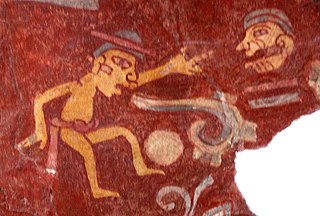
Language is a structured system of communication that consists of grammar and vocabulary. It is the primary means by which humans convey meaning, both in spoken and written forms, and may also be conveyed through sign languages. The vast majority of human languages have developed writing systems that allow for the recording and preservation of the sounds or signs of language. Human language is characterized by its cultural and historical diversity, with significant variations observed between cultures and across time. Human languages possess the properties of productivity and displacement, which enable the creation of an infinite number of sentences, and the ability to refer to objects, events, and ideas that are not immediately present in the discourse. The use of human language relies on social convention and is acquired through learning.

Phonology is the branch of linguistics that studies how languages systematically organize their phones or, for sign languages, their constituent parts of signs. The term can also refer specifically to the sound or sign system of a particular language variety. At one time, the study of phonology related only to the study of the systems of phonemes in spoken languages, but may now relate to any linguistic analysis either:

In linguistics, syntax is the study of how words and morphemes combine to form larger units such as phrases and sentences. Central concerns of syntax include word order, grammatical relations, hierarchical sentence structure (constituency), agreement, the nature of crosslinguistic variation, and the relationship between form and meaning (semantics). There are numerous approaches to syntax that differ in their central assumptions and goals.

In linguistics and related fields, pragmatics is the study of how context contributes to meaning. The field of study evaluates how human language is utilized in social interactions, as well as the relationship between the interpreter and the interpreted. Linguists who specialize in pragmatics are called pragmaticians. The field has been represented since 1986 by the International Pragmatics Association (IPrA).
Historical linguistics, also termed diachronic linguistics, is the scientific study of language change over time. Principal concerns of historical linguistics include:
- to describe and account for observed changes in particular languages
- to reconstruct the pre-history of languages and to determine their relatedness, grouping them into language families
- to develop general theories about how and why language changes
- to describe the history of speech communities
- to study the history of words, i.e. etymology
- to explore the impact of cultural and social factors on language evolution.
Cognitive linguistics is an interdisciplinary branch of linguistics, combining knowledge and research from cognitive science, cognitive psychology, neuropsychology and linguistics. Models and theoretical accounts of cognitive linguistics are considered as psychologically real, and research in cognitive linguistics aims to help understand cognition in general and is seen as a road into the human mind.
An adjective phrase is a phrase whose head is an adjective. Almost any grammar or syntax textbook or dictionary of linguistics terminology defines the adjective phrase in a similar way, e.g. Kesner Bland (1996:499), Crystal (1996:9), Greenbaum (1996:288ff.), Haegeman and Guéron (1999:70f.), Brinton (2000:172f.), Jurafsky and Martin (2000:362). The adjective can initiate the phrase, conclude the phrase, or appear in a medial position. The dependents of the head adjective—i.e. the other words and phrases inside the adjective phrase—are typically adverb or prepositional phrases, but they can also be clauses. Adjectives and adjective phrases function in two basic ways, attributively or predicatively. An attributive adjective (phrase) precedes the noun of a noun phrase. A predicative adjective (phrase) follows a linking verb and serves to describe the preceding subject, e.g. The man is very happy.
In sociolinguistics, a variety, also known as a lect or an isolect, is a specific form of a language or language cluster. This may include languages, dialects, registers, styles, or other forms of language, as well as a standard variety. The use of the word "variety" to refer to the different forms avoids the use of the term language, which many people associate only with the standard language, and the term dialect, which is often associated with non-standard language forms thought of as less prestigious or "proper" than the standard. Linguists speak of both standard and non-standard (vernacular) varieties as equally complex, valid, and full-fledged forms of language. "Lect" avoids the problem in ambiguous cases of deciding whether two varieties are distinct languages or dialects of a single language.
In linguistics and grammar, a sentence is a linguistic expression, such as the English example "The quick brown fox jumps over the lazy dog." In traditional grammar it is typically defined as a string of words that expresses a complete thought, or as a unit consisting of a subject and predicate. In non-functional linguistics it is typically defined as a maximal unit of syntactic structure such as a constituent. In functional linguistics, it is defined as a unit of written texts delimited by graphological features such as upper-case letters and markers such as periods, question marks, and exclamation marks. This notion contrasts with a curve, which is delimited by phonologic features such as pitch and loudness and markers such as pauses; and with a clause, which is a sequence of words that represents some process going on throughout time. A sentence can include words grouped meaningfully to express a statement, question, exclamation, request, command, or suggestion.
A surface, as the term is most generally used, is the outermost or uppermost layer of a physical object or space.
Linking R and intrusive R are sandhi phenomena where the rhotic consonant is pronounced as sound between two consecutive vowels with the purpose of avoiding a hiatus, that would otherwise occur in the expressions, such as tuner amp, although in isolation tuner is pronounced the same as tuna. These phenomena occur in many non-rhotic varieties of English, such as those in most of England and Wales, parts of the United States, and all of the Anglophone societies of the southern hemisphere, with the exception of South Africa. In these varieties, the sound is pronounced only when it is immediately followed by a vowel.
The term predicate is used in one of two ways in linguistics and its subfields. The first defines a predicate as everything in a standard declarative sentence except the subject, and the other views it as just the main content verb or associated predicative expression of a clause. Thus, by the first definition the predicate of the sentence Frank likes cake is likes cake. By the second definition, the predicate of the same sentence is just the content verb likes, whereby Frank and cake are the arguments of this predicate. Differences between these two definitions can lead to confusion.
Text linguistics is a branch of linguistics that deals with texts as communication systems. Its original aims lay in uncovering and describing text grammars. The application of text linguistics has, however, evolved from this approach to a point in which text is viewed in much broader terms that go beyond a mere extension of traditional grammar towards an entire text. Text linguistics takes into account the form of a text, but also its setting, i. e. the way in which it is situated in an interactional, communicative context. Both the author of a text as well as its addressee are taken into consideration in their respective roles in the specific communicative context. In general it is an application of discourse analysis at the much broader level of text, rather than just a sentence or word.
Cognitive grammar is a cognitive approach to language developed by Ronald Langacker, which hypothesizes that grammar, semantics, and lexicon exist on a continuum instead of as separate processes altogether. This approach to language was one of the first projects of cognitive linguistics. In this system, grammar is not a formal system operating independently of meaning. Rather, grammar is itself meaningful and inextricable from semantics.
Victoria Alexandra Fromkin was an American linguist who taught at UCLA. She studied slips of the tongue, mishearing, and other speech errors, which she applied to phonology, the study of how the sounds of a language are organized in the mind.
Andrew Carnie is a Canadian professor of linguistics at the University of Arizona. He is the author or coauthor of nine books and has papers published on formal syntactic theory and on linguistic aspects of Scottish Gaelic and Irish Gaelic. He was born in Calgary, Alberta. He is also a teacher of Balkan and international folk dance. In 2009, he was named as one of the Linguist List's Linguist of the Day. From 2010-2012, he has worked as the faculty director of the University of Arizona's Graduate Interdisciplinary Programs. In August 2012, he was appointed interim Dean of the graduate college. From 2013-2022, he worked as the Vice Provost for Graduate Education and Dean of the Graduate College. In that role he founded the University's Graduate Center, established the university's Graduate faculty, significantly increased student diversity, and worked to establish better working conditions and wages for students.
In the tree model of historical linguistics, a proto-language is a postulated ancestral language from which a number of attested languages are believed to have descended by evolution, forming a language family. Proto-languages are usually unattested, or partially attested at best. They are reconstructed by way of the comparative method.
Linguistics is the scientific study of language. The modern-day scientific study of linguistics takes all aspects of language into account — i.e., the cognitive, the social, the cultural, the psychological, the environmental, the biological, the literary, the grammatical, the paleographical, and the structural.
Formal semantics is the study of grammatical meaning in natural languages using formal tools from logic, mathematics and theoretical computer science. It is an interdisciplinary field, sometimes regarded as a subfield of both linguistics and philosophy of language. It provides accounts of what linguistic expressions mean and how their meanings are composed from the meanings of their parts. The enterprise of formal semantics can be thought of as that of reverse-engineering the semantic components of natural languages' grammars.

Bantoanon or Asi is a regional Bisayan language spoken, along with Romblomanon and Onhan, in the province of Romblon, Philippines. Asi originated in the island of Banton, Romblon and spread to the neighboring islands of Sibale, Simara, and the towns of Odiongan and Calatrava on Tablas Island. The Asi spoken in Odiongan is called Odionganon, Calatravanhon in Calatrava, Sibalenhon in Concepcion, Simaranhon in Corcuera, and Bantoanon in Banton.


